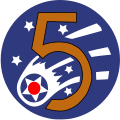| 64th Bombardment Squadron | |
|---|---|
 B-58 Hustler in flight [note 1] | |
| Active | 1941–1946; 1946–1970 |
| Country | |
| Branch | |
| Role | Bombardment |
| Engagements | Southwest Pacific Theater |
| Decorations | Distinguished Unit Citation Air Force Outstanding Unit Award Philippine Presidential Unit Citation [1] |
| Insignia | |
| 64 Bombardment Sq emblem (B-58 era) |  |
| Patch with 64th Bombardment Squadron emblem [2] [note 2] |  |
The 64th Bombardment Squadron is an inactive United States Air Force unit that was last assigned to the 43rd Bombardment Wing at Little Rock Air Force Base, Arkansas, where it was inactivated on 31 January 1970.
Contents
- History
- World War II
- Strategic Air Command operations
- Lineage
- Assignments
- Stations
- Aircraft
- Awards and campaigns
- See also
- References
- Notes
- Bibliography
- External links
The squadron was first activated in January 1941, as one of the original squadrons of the 43rd Bombardment Group. Following the attack on Pearl Harbor, the squadron participated in antisubmarine patrols until January 1942, when it moved to Australia and the Southwest Pacific Theater. It moved forward with US forces through New Guinea and the Philippines, moving to Ie Shima shortly before V-J Day for operations against Japan. It earned two Distinguished Unit Citations and a Philippine Presidential Unit Citation for combat operations. The squadron was inactivated in the Philippines in April 1946.
The squadron was activated again in October 1946, when it assumed the resources of another unit. It operated propeller-driven Boeing B-29 Superfortresses and Boeing B-50 Superfortresses until 1954, when it upgraded to the jet Boeing B-47 Stratojet. In 1960, the squadron moved to Carswell Air Force Base, Texas, where it became one of the Air Force's first supersonic Convair B-58 Hustler units. It continued to operate the Hustler until it was inactivated.




